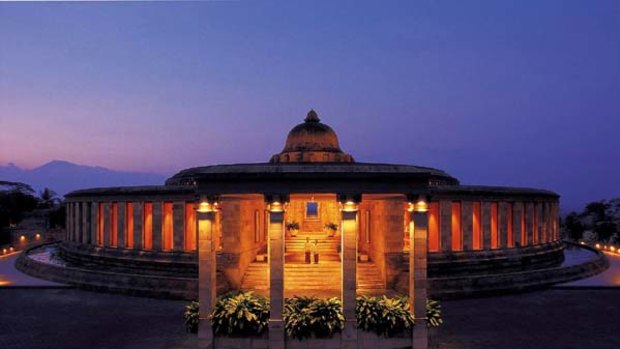
Place to reflect ... the colonnaded reception area of Amanjiwo Resort.
The immaculate four-wheel-drive in which we are passengers stops on the approach ramp and there, through the perfectly aligned frame of Amanjiwo's main entrance, is Borobudur. Distant, hazy, mysterious. Made famous in the 19th century by Sir Stamford Raffles - founder of Singapore and, later, a British ruler of Java - the ninth-century Buddhist monument should be on every traveller's "bucket list".
The check-in at Amanjiwo takes place under a main cupola built to resemble a classic pantheon for the gods. The spacious dome also houses the library, bar and main restaurant but the latter are placed inconspicuously so that all you see at first glance is a resting place from which to sit and admire Borobudur and the mighty volcanoes that originally buried it in ash.
The sense of openness and space at the hotel is achieved partly by the absence of walls, allowing the breeze to circulate through the colonnade. An eerie, melodious sound flows from a group of musicians gathered under the dome. They are a cokekan, an ensemble of eight. As with chamber groups in the West's classical tradition, cokekan ensembles have evolved in Central Java from the bigger gamelan groups intended to accompany ceremonies in palaces. The songs are so old, the female vocalist tells me, she doesn't quite understand their meaning because they were passed from generation to generation in Kawi, an ancient language used by holy men.
Borobudur, the world's largest Buddhist sanctuary, is in the middle of Central Java's Kedu plain, a one-hour drive from Yogyakarta. Built to look like a lotus flower dropped from the sky, theories suggest a lake once surrounded the pyramid, completing the image of a lotus pond.
The rich volcanic soil makes the area an agricultural paradise, despite the eruptions that both buried the huge temple site and caused locals to migrate to other parts of the island.
Led by reports of "a big temple buried in the jungle", Raffles appointed a team to investigate. After slashing and burning the strangling vegetation and removing tonnes of ash, by 1835, Borobudur was visible in all its splendour. The years that followed saw friezes and Buddha statue heads disappear into the hands of antiquities dealers. The Dutch and Indonesian governments then undertook generations of reconstruction work. Today, Borobudur is Indonesia's most-visited attraction.
The call comes through to our villa at Amanjiwo at 4am. It's difficult to abandon the bed, built on a stone platform, but we paddle softly around on the marble floors gathering our gear and noticing how enticing our private pool looks, glinting in the moonlight.
Silently, we head for the main building, guided in the dark by the fragrances coming from its kitchen - freshly baked croissants and local coffee. Brushing past orange trees in blossom and mango trees laden with clusters of green fruit, we get to the croissants and, still in darkness, begin the 10-minute drive to the shrine.
Against a light-grey sky, Borobudur rises before our eyes, dark grey stone carved with scenes from the Buddha's life and teachings. As we climb the steps to the higher terraces, the monument's famous bell-shaped stupas, housing a Buddha each, are so close we can lean forward and peer through the lattice work and see the statue each protects. After walking around the different levels, we leave the site to a school group and dozens of girls wearing headscarves.
Our driver then takes us to a mound opposite the monument, from which we can admire this World Heritage-listed site. Framed by palm trees and other vegetation, the central Borobudur stupa looks like a Buddha's head about to emerge from the pyramid. On the way back, we stop at local markets, where a cornucopia of fresh produce spills from thousands of baskets.
Back at Amanjiwo, we head for the library, a cool space of Moorish-style decor, with ample beds for reclining on and plenty of books dedicated to Borobudur. The interior is light and the floor-to-ceiling shelves are chock-a-block with good reading material. Nearby, there are small trestle tables holding generous-sized glass teapots filled with citrus-scented iced tea.
When I finally make it back to our villa, I find a note from the hotel's Australian manager reconfirming that his preferred walk - 45 minutes away by car - has been booked for us. He also says a member of staff has advised that there will be a jatiland (ancient trance dance) in the local village tomorrow night, should we wish to attend.
Later that afternoon, while doing a lap of the resort's Olympic-length pool and surrounded by volcanoes, a frisson of fear courses through me and I wonder how people can live so happily in the company of such portentous and unpredictable neighbours.
The writer was a guest of Amanjiwo Resort.
TRIP NOTES
Amanjiwo Resort, Central Java, Indonesia. Phone +62 293 788 333, see amanresorts.com.
Private villas are priced from $US700 ($763) a night; $US1950 for three nights. Breakfast and three complimentary activities, from a menu of 12, are included in the price.
The management strives to integrate as many genuine cultural experiences as possible.
The villas' distance from reception and the resort's hillside position mean a lot of walking up and down steps.
The markets in the nearby village.
Sign up for the Traveller Deals newsletter
Get exclusive travel deals delivered straight to your inbox. Sign up now.